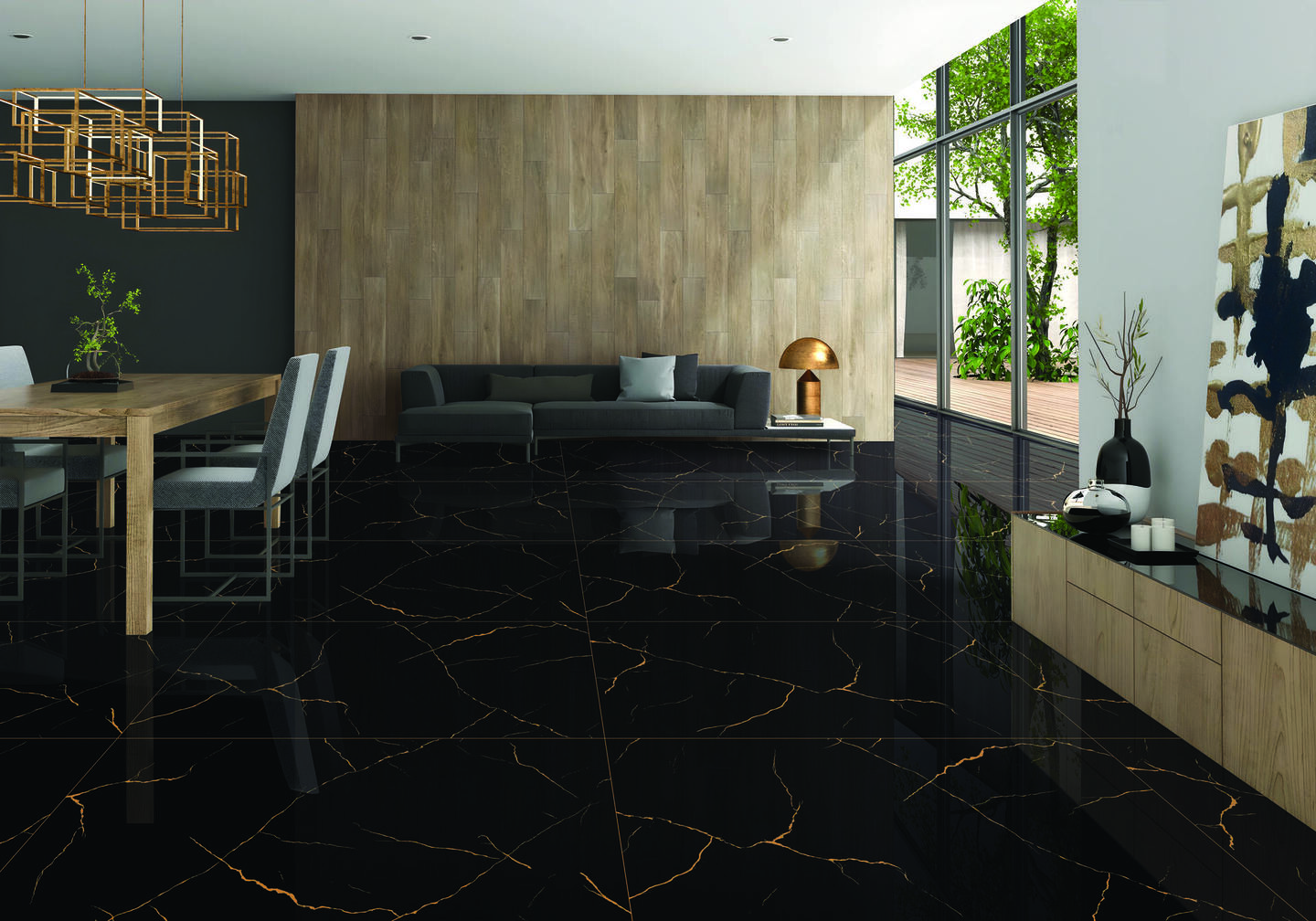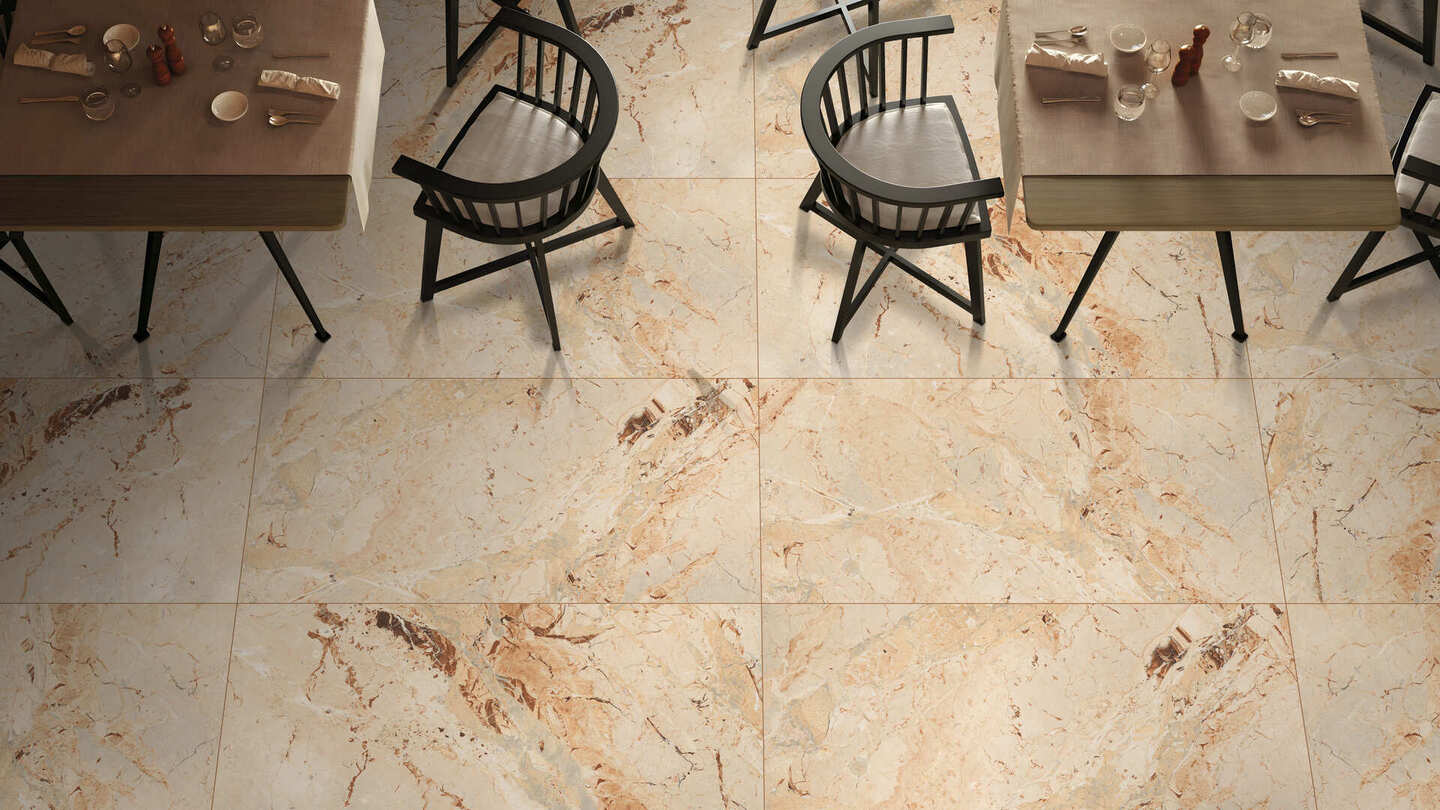Vitrified vs. Ceramic: What’s the difference?

The look of a house is greatly influenced by the tiles, which are integral parts of its interior and exterior design.
In today's market, various tile options are available for customers; they often get confused about which tiles they should select. Among them, vitrified and ceramic tiles are most commonly used.
As Vitrified tiles and ceramic tiles look alike, it can be hard to choose between the two. The composition of the clay-based mixture is what differentiates the two tiles.
In this article, we’ll discuss the key difference between vitrified tiles and ceramic tiles. This will surely help you identify ceramic and vitrified tiles, and which is better for your needs.
What Are Vitrified Tiles?

Vitrified tiles are made of a mixture of clay and silica at a ratio of 40:60. There are also other materials like feldspar and quartz used for composition.
When these mixtures are heated in the kiln at a high temperature, they merge, forming a glossy and hard vitreous surface. This process of manufacturing vitrified tiles is known as “vitrification.”
Vitrified tiles are highly durable, water resistant, and low-maintenance, making them the best choice for high-foot traffic areas like commercial spaces.
They offer marble and granite-like finishes, with better durability and lower cost compared to natural stone. It makes them an ideal choice for residences.
Interested in knowing more about Vitrified Tiles in detail? Then read the article: Everything You Need To Know About Vitrified Tiles.
Sanford Vitrified stands on the frontline as a leading vitrified tiles manufacturer and exporter in India. With over a decade of experience and taking inspiration from the latest trends, we create a world-class vitrified floor and wall tiles collection to add aesthetic appeal to your home and office.
What Are Ceramic Tiles?
Ceramic tiles are primarily made of natural clay combined with water and moulded. These tiles are heated at an extremely high temperature in a kiln. This gave him a rough texture with a realistic and earthy look.
Available in numerous colours and finishes, ceramic tiles are easy to install and replace. But these tiles are porous and retain additional water, which makes them unsuitable for areas where the moisture is constant.
Ceramic tiles are often glazed to protect them from scratches, stains, and water. Thus, a thick layer of glaze makes ceramic tiles a good choice for flooring, backsplashes, and kitchen countertops.
14 Key Differences Between Vitrified Tiles and Ceramic Tiles

| Sr. No. | Vitrified vs. Ceramic Tiles Parameters of Comparison | Vitrified Tiles | Ceramic Tiles |
| 1 | Composition | The materials used in vitrified tiles are clay, silica, feldspar and quartz. | Ceramic tiles are made up of earthen clay and water. |
| 2 | Finishes and texture | Vitrified tiles have an aesthetic look as the joints are less visible. The texture is smooth and glossy. | Ceramic tiles have a natural and earthy look. Their texture is relatively rough and glazed. |
| 3 | Glazing | Vitrified tiles don’t need to be glazed. Shine can be achieved by mansion polish. | As a protection measure, ceramic tiles are always glazed. |
| 4 | Durability | Vitrified tiles are highly durable due to their glossy and hard surfaces. It must be the existence of extra minerals in the mixture. | Ceramic tiles are less durable. |
| 5 | Strength | Vitrified tiles are stronger.The flexural strength is high, at around 35 N/mm2 and the breaking strength is 700N. | Less strong than vitrified tiles. Ceramic tiles have low flexural strength, which is around 20 N/mm2 and the breaking strength is 200 N. |
| 6 | Maintenance | Vitrified tiles are easy to maintain due to their shiny surface. It is easy to clean. | Comparatively, maintaining ceramic tiles needs quite the effort. The surface of ceramic tiles tends to absorb stains. |
| 7 | Installation | Vitrified tiles are easy to install and don't require skilled labour. | Ceramic tiles are difficult to install compared to vitrified tiles and require skilled labour. |
| 8 | Size and Thickness |
The size of vitrified tiles is available in 2 feet*2 feet(24” x 24”) and more. Thickness: 8mm to 12mm. |
The size of ceramic tiles is comparatively smaller than vitrified tiles. Thickness: 6mm to 12mm. |
| 9 | Cost | Vitrified tiles are a little bit more costly because of their fine qualities. These tiles need stronger adhesive, which can increase the cost of installation. | The cost of ceramic tiles is lower than that of vitrified tiles. |
| 10 | Water absorption | Vitrified tiles are not porous, so the water absorption is less. | Ceramic tiles are more porous and therefore, water absorption is more. |
| 11 | Frost resistance | Vitrified tiles have high frost resistance due to less water absorbent. | Ceramic tiles have low frost resistance compared to vitrified tiles. These tiles absorb water quickly. |
| 12 | Staining resistance | Vitrified tiles are resistant to staining due to their glossy-like finishes and are non-porous. It is also easy to clean. | Ceramic tiles are less resistant to staining compared to vitrified tiles. It's hard to clean because of its texture. |
| 13 | Slip resistance | Compared to ceramic tiles, vitrified tiles are very slippery when wet. | Ceramic tiles are not as slippery as vitrified tiles. These tiles prevent slipping. |
| 14 | Colour resistance to UV light | Sunlight does not affect vitrified tiles. The tile's shine does not fade away over time. | Ceramic tiles are porous to nature, direct exposure to sunlight can fade the tiles. |
How To Identify Vitrified Tiles and Ceramic Tiles?
Vitrified tiles are acknowledged for their glossy look, whereas ceramic tiles have coarse(rough) textures.
Vitrified tiles have a shiny appearance and give an aesthetic touch. While ceramic tiles have a more earthy and natural look.
Vitrified tiles are stronger than ceramic tiles due to extra minerals in the mixture of clay.
Vitrified vs. Ceramic tiles- Which Is Better For Your Needs?
Ceramic and vitrified tiles are two different best options for flooring and wall. It isn’t easy to choose which tiles are suitable for your needs.
You may discover which tiles are more suitable for your place based on your requirements. From the above discussion, we have compiled the pros and cons of vitrified tiles vs. ceramic tiles below the table:
| Vitrified Tiless | Ceramic Tiless |
| Mixture of clay, silica, feldspar and quartz | Made of natural clay and water. |
| stronger | Less strong |
| Glossy and smooth surface | Rough texture |
| Less porous | Porous |
| More resistance to stain, scratches and UV light | Less resistance to stain, scratches and UV light |
| More water-absorbent | Less water-absorbent |
| Highly durable | Less durable |
| Low maintenance and easy to clean | Need more maintenance and not easy to clean |
Vitrified tiles are highly recommended for high foot traffic areas such as living rooms because of their low porosity and aesthetic appeal. Whereas ceramic tiles are best for kitchens, bathrooms, and stairwells due to their less slippery factor. But, ceramic tiles easily break down due to being less water absorbent and less durable.
How Can Sanford Vitrified Help You?
We hope this article helps you understand the difference between vitrified tiles and ceramic tiles . With this difference, you’re a step closer to making the right flooring tiles for your home and office.
Sanford Vitrified, a premier vitrified tile manufacturer across India, believes in creating innovative and stunning tiles that give your space a signature look. We deliver customised tiles by integrating cutting-edge technology with our professional expertise.



